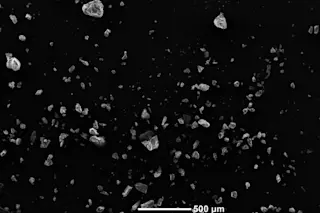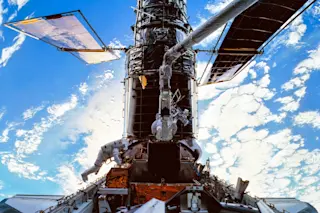The target is 230 million miles away and 22 miles long. It is an asteroid, and NASA plans to put a spacecraft in orbit around it.
When the Mars Observer vanished last August, many planetary scientists regretted the all-or-nothing design of the billion-dollar spacecraft. Had its many instrument packages been carried separately by smaller, cheaper probes, researchers might now be poring over Martian photos instead of pining for a replacement mission. In that respect, at least, NASA has heard its many critics: its new program of unmanned space exploration calls for a series of low-cost, unmanned probes with tightly focused goals.
But low-cost does not necessarily mean low-risk or technically routine. On the contrary, in the first of these new missions NASA is going for something completely different: it plans to send a spacecraft to an asteroid--not just for a quick flyby, which the Galileo probe has already done, but to orbit the 22-mile-long space rock for a full year. It would be the first time a spacecraft has ever orbited anything smaller than the moon.
The Near-Earth Asteroid Rendezvous (NEAR) spacecraft will be built at the Johns Hopkins Applied Physics Laboratory. If all goes as planned, a Delta 2 booster rocket will lift the $150 million, 1,700-pound probe into space in February 1996. Nearly three years later, in December 1998, the spacecraft will drop into orbit around the asteroid Eros.
Eros is a renegade. Discovered in 1898, it was the first asteroid found outside the 150-million-mile-wide belt between Mars and Jupiter in which most asteroids orbit the sun. Eros is one of 200 near Earth asteroids: its orbit reaches into the asteroid belt, but instead of paralleling the planets, it crosses the path of Mars and sometimes approaches Earth’s orbit. In 1975 it passed within 14 million miles of us.
When the golf cart-size NEAR probe reaches Eros in 1998, the asteroid will be much farther away--out beyond Mars, 230 million miles from Earth. To get there, the NEAR craft will follow a loopy trajectory, first shooting by Mars’ orbit in August 1996. Then, early in 1997, the spacecraft will begin heading back to Earth, coming within 300 miles of home. Pulled by Earth’s gravitational field, it will draw fresh momentum as the planet whips around the sun at about 70,000 miles per hour. That gravitational assist will send NEAR into a giant U-turn that will sling it out to Eros.
If the NEAR probe lives up to its name, it will give researchers their closest-ever look at an asteroid, as well as their longest. NASA intends to orbit the spacecraft just 15 miles above Eros’ surface. Getting NEAR into such a tight orbit around a rock just twice the size of Manhattan will be a delicate task. That’s when the fun really begins, says Andrew Cheng, the mission scientist for NEAR.
A month or two before NEAR reaches Eros, ground controllers will begin cutting NEAR’s speed from 3,000 feet per second to about 15. We have to bring it down to very low speed because Eros is so small, says Cheng. Its gravity is very weak. If you were going too fast, it could not capture you. I’d bet that if you took a running jump off Eros, you’d end up in orbit.
The mission scientists will need an extremely accurate measurement of the potato-shaped asteroid’s lopsided gravitational field in order to precisely control the spacecraft’s orbit. So after slowing NEAR down, the ground crew will first let it glide by Eros. By measuring the Doppler shift of radio signals from the spacecraft, the researchers will be able to determine how the asteroid’s gravity affects the probe. Only then will the controllers begin firing the probe’s thrusters again to maneuver it into orbit.
Then NEAR will survey Eros for a year. Spectrometers will map the elements and minerals on the asteroid’s surface, a high-resolution camera will capture details as small as three feet across, and a magnetometer will reveal whether Eros has a weak magnetic field. Since asteroids are relics of the early solar system, researchers hope NEAR’s long look at Eros will provide insights into the conditions that prevailed when Earth and the other planets were born.
But all that will depend on getting NEAR into orbit around Eros in the first place. It’s never been done before, says Cheng. It’s certainly a challenge. We think we know how to do it.














